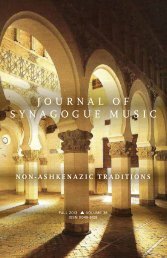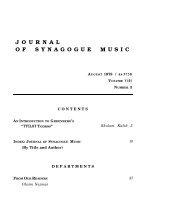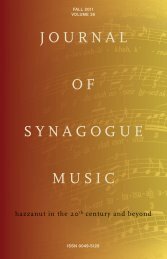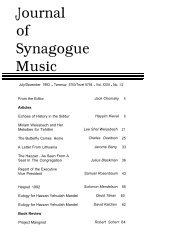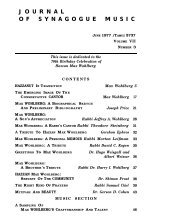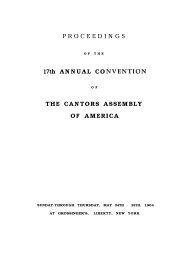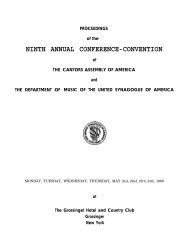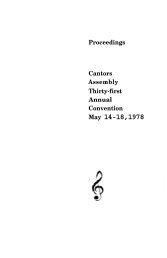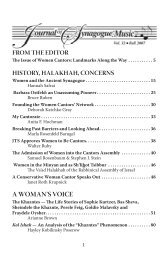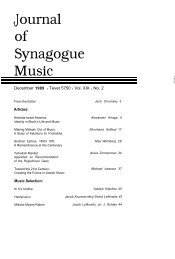Volume 16, Number 2 - Cantors Assembly
Volume 16, Number 2 - Cantors Assembly
Volume 16, Number 2 - Cantors Assembly
Create successful ePaper yourself
Turn your PDF publications into a flip-book with our unique Google optimized e-Paper software.
However, my initial assumption that it would be possible to identify<br />
the origin of the melody, and to assign it to one of the types of the<br />
contemporary repertory, proved over-optimistic. Specialists in the field<br />
have so far been unable to locate formal contemporary models with<br />
which our melody can be associated.29 While awaiting further research<br />
we must content ourselves with a presentation of the principal features<br />
that emerge from an analysis of the melodic structure of our tune,<br />
It seems then that we may most reasonably discard a contrafactum<br />
hypothesis, and posit that the melody was composed especially for the<br />
text of zfiv mis’-SellG by an anonymous Jewish composer, perhaps in the<br />
second half of the fifteenth century, or at the latest, at the beginning of the<br />
sixteenth. The notion that a preexisting melody from the popular<br />
repertoire of the period was fitted to the words of the piyyut may be<br />
rejected on the grounds of our inability to identify an existing model in<br />
contemporary chant, as well as on the basis of several conclusions<br />
suggested by analysis of the tune, such as the extended ambitus of an<br />
octave and fourth, which is rare in the popular monodic repertory of the<br />
Geistliche Lieder and similar chants of the period; a significant<br />
interrelationship between the text and the tune; and the use of variation<br />
technique in the melody of the different strophes, especially in IV, as we<br />
shall see below.<br />
We have already pointed out (section 11,l) the similarity between the<br />
poetic and musical structures which may be observed in the parallels<br />
between the cadential formula of the refrain and that of the ends of the<br />
strophes. This, and other aspects of the melodic analysis, may be made<br />
clear with the help of a paradigmatic transcription of the melody of the<br />
five strophes (see Transcription II).<br />
29. My heartfelt thanks are due to Prof. Ludwig Finscher of Heidelberg and Dr.<br />
Karl-Gunther Hartmann of Kassel to whom I appealed in this matter. The beginning of<br />
the melody seems to Finscher “like a French chanson melody from the Janequin<br />
generation or slightly later; such melodies were frequently borrowed for Protestant<br />
church songs. The continuation, however, looks strange, and I cannot fit it inro any<br />
repertoire known to me” (letter dated 17.12.1984). On Finscher's advice I applied to<br />
Dr. Hartmann, from whose reply, dated 29.1.85, I quote the following extracts: “...Die<br />
Form des Stuckes gibt Ratsel auf... Aus der Zeit un 1520 ist mir nichts vergleichbares<br />
bekannt... I hre Melodie fangt an wieein Tanzlied. besonders die Kadenz von A lstrophe I.<br />
See Transcription Ill weckt diese Assoziation... lesl erhartet sich mir der Verdacht, dass<br />
auch die Form des Ganzen aus der gleichen Spare stammen konnte... Einige Merkmale...<br />
lassen an Spatformen der Estampie denken... lch werde das Stucke weiter im Auge<br />
behalten und bitte um Kachsicht fur meine noch sehr vagen Vermutungen.”<br />
27



